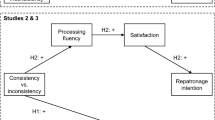Abstract
In many product categories, unit prices facilitate price comparisons across brands and package sizes; this enables consumers to identify those products that provide the greatest value. However in other product categories, unit prices may be confusing. This is because there are two types of unit pricing, measure-based and usage-based. Measure-based unit prices are what the name implies; price is expressed in cents or dollars per unit of measure (e.g., ounce). Usage-based unit prices, on the other hand, are expressed in terms of cents or dollars per use (e.g., wash load or serving). The results of this study show that in two different product categories (i.e., laundry detergent and dry breakfast cereal), measure-based unit prices reduced consumers’ ability to identify higher value products, but when a usage-based unit price was provided, their ability to identify product value was increased. When provided with both a measure-based and a usage-based unit price, respondents did not perform as well as when they were provided only a usage-based unit price, additional evidence that the measure-based unit price hindered consumers’ comparisons. Finally, the presence of two potential moderators, education about the meaning of the two measures and having to rank order the options in the choice set in terms of value before choosing, did not eliminate these effects.
Similar content being viewed by others
References
D. Aaker G. T. Ford (1983) ArticleTitleUnit pricing ten years later: A replication Journal of Marketing 47 IssueID4 118–122
Appelbaum, C. (1991). Colgate readies new ads for fresh start. Adweek, March 11, 10.
B. Bauer (1994) ArticleTitleDynamic detergents; the popularity of ultra concentrates is forcing most retailers to frequently reset the laundry aisle Supermarket News 44 IssueID15 39
J. R. Bettman E. J. Johnson J. W. Payne (1991) Consumer decision making T. S. Robertson H. H. Kassarjian (Eds) Handbook of consumer behavior Prentice Hall Englewood Cliffs, NJ 50–84
I. Breskin (1995) ArticleTitleConsumers resist increased liquid concentration Chemical Week 156 IssueID3 39
J. Cohen P. Cohen (1983) Applied multiple regression: Correlation analysis for the behavioral sciences EditionNumber2 Lawrence Erlbaum Hillsdale, NJ
InstitutionalAuthorNameConsumers Union of the U.S. (1995) ArticleTitleLaundry detergents: Do good things come in small packages? Consumer Reports 60 IssueIDFebruary 92
Consumer-friendly labels sought for liquid laundry soap (1995). Marketing News, 29(January 30), 9.
E. H. Creyer W. T. Ross (1997) ArticleTitleTradeoffs between price and quality: How a value index affects preference formation Journal of Consumer Affairs 31 280–302
P. R. Dickson A. G. Sawyer (1990) ArticleTitleThe price knowledge and search of supermarket shoppers Journal of Marketing 54 IssueID3 42–53
E. T. Garman (1996) Consumer economic issues in America EditionNumber4 Dame Publications Houston, TX
C. W. Granger A. Billson (1972) ArticleTitleConsumers’ attitudes toward package size and price Journal of Marketing Research 9 239–248
W. D. Hoyer (1984) ArticleTitleAn examination of consumer decision making for a common repeat purchase product Journal of Consumer Research 11 822–829 Occurrence Handle10.1086/209017
H. R. Isakson A. R. Maurizi (1973) ArticleTitleThe consumer economics of unit pricing Journal of Marketing Research 10 277–285
E. J. Johnson J. W. Payne (1985) ArticleTitleEffort and accuracy in choice Management Science 31 395–414
E. J. Johnson J. W. Payne J. R. Bettman (1988) ArticleTitleInformation displays and preference reversals Organizational Behavior and Human Decision Processes 42 1–21 Occurrence Handle10.1016/0749-5978(88)90017-9
E. J. Johnson J. E. Russo (1984) ArticleTitleProduct familiarity and learning new information Journal of Consumer Research 11 542–550
K. C. Manning D. E. Sprott A. D. Miyazaki (1998) ArticleTitleConsumer responses to quantity surcharges: Implications for retail price setters Journal of Retailing 74 373–399
B. F. McElroy D. A. Aaker (1979) ArticleTitleUnit pricing six years after introduction Journal of Retailing 3 44–57
V.-W. Mitchell D. Lennard P. McGoldrick (2003) ArticleTitleConsumer awareness, understanding and usage of unit pricing British Journal of Management 14 173–187 Occurrence Handle10.1111/1467-8551.00273
A. D. Miyazaki D. E. Sprott K. Manning (2000) ArticleTitleUnit prices on retail shelf labels: An assessment of information prominence Journal of Retailing 76 93–112 Occurrence Handle10.1016/S0022-4359(99)00022-6
K. B. Monroe A. Y. Lee (1999) ArticleTitleRemembering versus knowing: Issues in buyers’ processing of price information Journal of the Academy of Marketing Science 27 207–225
Mullin, R. (1992). Canada was lukewarm on concentrates in ’91, Chemical Week, January 29, 42–44.
Neff, J. (1999). Clorox joins bandwagon for ultra-strength brands. Advertising Age, November 29, 14.
J. E. Russo (1977) ArticleTitleThe value of unit price information Journal of Marketing Research 14 193–201
J. E. Russo G. Kreiser S. Miyashita (1975) ArticleTitleAn effective display of unit price information Journal of Marketing 39 IssueID2 11–19
Slovic, P. (1972). From Shakespeare to Simon: Speculations – and some evidence about mom’s ability to process information. Oregon Research Institute Research Monograph, 12(2).
Turcsik, R. (1994). A powerful formula: Liquid detergents, led by ultra concentrates, are showing strength in a lackluster category. Supermarket News, 44(November 7), 37–38, 42.
Walsh, T., & Hume, C. (1999). Soaps and detergents – Sharing the risks and rewards. Chemical Week, 161(January 27), 25–28.
T. Walsh C. Hume (2000) ArticleTitleSoaps and detergents – Rising costs burst soapers’ bubbles Chemical Week 162 IssueIDJanuary 26 27–29
V. A. Zeithaml (1982) ArticleTitleConsumer response to in-store price environments Journal of Consumer Research 8 357–369 Occurrence Handle10.1086/208876
Author information
Authors and Affiliations
Corresponding author
Rights and permissions
About this article
Cite this article
Kwortnik, R.J., Creyer, E.H. & Ross, W.T. Usage-Based versus Measure-Based Unit Pricing: Is there a Better Index of Value?. J Consum Policy 29, 37–66 (2006). https://doi.org/10.1007/s10603-005-6054-x
Issue Date:
DOI: https://doi.org/10.1007/s10603-005-6054-x




